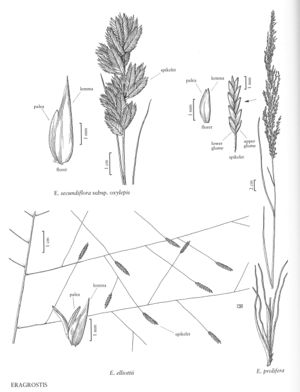Difference between revisions of "Eragrostis secundiflora"
FNA>Volume Importer |
imported>Volume Importer |
||
| (7 intermediate revisions by 2 users not shown) | |||
| Line 26: | Line 26: | ||
-->{{#Taxon: | -->{{#Taxon: | ||
name=Eragrostis secundiflora | name=Eragrostis secundiflora | ||
| − | |||
|authority=J. Presl | |authority=J. Presl | ||
|rank=species | |rank=species | ||
| Line 33: | Line 32: | ||
|basionyms= | |basionyms= | ||
|family=Poaceae | |family=Poaceae | ||
| + | |illustrator=Linda A. Vorobik;Cindy Roché | ||
| + | |illustration copyright=Utah State University | ||
|distribution=Va.;Kans.;Okla.;Colo.;Miss.;Tex.;La.;Calif.;N.C.;Ala.;Nebr.;Tenn.;Ark.;Ga.;S.C.;Fla.;Mo.;N.Mex. | |distribution=Va.;Kans.;Okla.;Colo.;Miss.;Tex.;La.;Calif.;N.C.;Ala.;Nebr.;Tenn.;Ark.;Ga.;S.C.;Fla.;Mo.;N.Mex. | ||
|reference=None | |reference=None | ||
| Line 38: | Line 39: | ||
|publication year= | |publication year= | ||
|special status= | |special status= | ||
| − | |source xml=https:// | + | |source xml=https://bitbucket.org/aafc-mbb/fna-data-curation/src/200273ad09963decb8fc72550212de541d86569d/coarse_grained_fna_xml/V25/V25_159.xml |
|subfamily=Poaceae subfam. Chloridoideae | |subfamily=Poaceae subfam. Chloridoideae | ||
|tribe=Poaceae tribe Cynodonteae | |tribe=Poaceae tribe Cynodonteae | ||
Latest revision as of 18:57, 11 May 2021
Plants perennial; cespitose, with innovations, without rhizomes, not glandular. Culms 30-75 cm, erect, glabrous below. Sheaths mostly glabrous, hairy at the apices, hairs to 4 mm; ligules 0.2-0.3 mm; blades 10-25(40) cm long, 1-5 mm wide, involute, glabrous abaxially, scabridulous adaxially, sometimes also sparsely pilose. Panicles (3)5-30 cm long, 1-15 cm wide, from narrowly oblong, glomerate, and interrupted below to ovate and open; primary branches 0.5-12(16) cm, appressed or diverging up to 40° from the rachises, stiff; pulvini glabrous or sparsely hairy; pedicels 0-1(3) mm, appressed, flattened. Spikelets 6-16(23) cm long, 2.4-5 mm wide, ovate to linear-elliptic, flattened, stramineous, with reddish-purple margins or completely reddish-purple, with 10-45 florets; disarticulation basipetal, florets falling intact and before the glumes. Glumes ovate-lanceolate to lanceolate, membranous; lower glumes 1.7-3 mm; upper glumes 2.2-4 mm, apices acuminate; lemmas 2-6 mm, ovate, membranous to leathery, apices usually acuminate or attenuate, sometimes acute; paleas 1.5-3 mm, membranous to leathery, narrower than the lemmas, apices obtuse, sometimes bifid; anthers 2, 0.2-0.5 mm, brownish. Caryopses 0.8-1.3 mm, ellipsoid, somewhat laterally flattened, smooth, reddish-brown. 2n = 40.
Distribution
Va., Kans., Okla., Colo., Miss., Tex., La., Calif., N.C., Ala., Nebr., Tenn., Ark., Ga., S.C., Fla., Mo., N.Mex.
Discussion
There are two subspecies of E. secundiflora; plants from the Flora region belong to E. secundiflora subsp. oxylepis (Torrey) S.D. Koch. They grow in sandy soils, dunes, grasslands, beaches, and roadsides of the south¬ern United States and northern Mexico, at 0-1000 m. Eragrostis secundiflora J. Presl subsp. secundiflora grows in Mexico and Central and South America.
Selected References
None.
